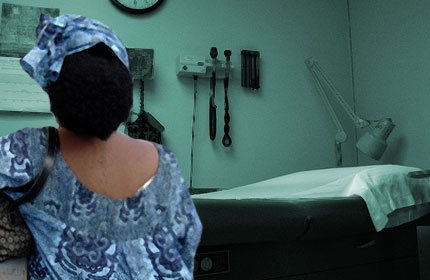City, State Do Little to Address Female Genital Cutting

For Angela Montague, it began with a young woman from the West African country of Guinea. In February 2008, Montague, a licensed clinical social worker and the assistant director of social work at the Metropolitan Hospital Center in East Harlem, received a referral from a doctor in the hospital's family planning clinic. A 19-year-old patient had come in complaining of abdominal pain and then broke down crying.
The young woman traced her physical and emotional pain to when she was 8 years old and the women in her community in Guinea had gathered to perform a rite of passage on her - namely, cutting off her clitoris.
"She came to see me the same day as her physical exam," Montague said. "She was clearly experiencing symptoms of post traumatic stress disorder. She had regular nightmares about the day she was cut, and she had difficulty concentrating because the memories would continually resurface. She even feared groups of people because it reminded her of the group of women who held her down while the cutting was performed."
Known alternately as female genital cutting (FGC) or female genital mutilation (FGM), the removal of all or part of the external female genitalia is practiced across cultures and religions in parts of Africa, Asia and the Middle East. It is generally performed by women on girls as part of the transition to adulthood. The World Health Organization estimates that between 100 million and 140 million women and girls worldwide have undergone FGC. In the United States, estimates suggest that the number of women and girls who have undergone FGC or who are at risk grew by about 35 percent between 1990 and 2000 - from 168,000 to 228,000. The New York metropolitan area is estimated to have the highest number of women and girls affected by or at risk of undergoing genital cutting in the United States: just under 41,000, according to estimates based on data from the 2000 census.
Montague saw the young woman regularly for counseling and began to receive referrals of other women in New York experiencing similar problems. When she spoke to her colleagues throughout the city about genital cutting, she discovered that many of them were not aware of the issue and that education on the health consequences of the practice was limited. And while some individual service providers were working to support women and girls who had undergone cutting, a comprehensive structure for addressing the issue remained unrealized at both the state and federal levels.
In fact, neither the city nor the state government has taken concrete steps to address the practice or its effects, which can range from post-traumatic stress disorder to severe infections, painful menstruation and complications during pregnancy and childbirth.
What the Government Is Not Doing
New York is one of 17 states that have passed legislation criminalizing the practice of FGC on minors. The state law, which is modeled on federal legislation that was also enacted in the mid-1990s, identifies both the person who performs the cutting as well as the parent or guardian who consents to it as being "guilty of female genital mutilation."
The law also required the state Departments of Health and Social Services (now the Office of Children and Family Services) to establish "education, preventive and outreach" activities in communities that traditionally practice FGC in order to inform them of the health consequences of the practice and the provisions of the state law.
Very little has been done, however, to implement either part of the law. The last sustained education and outreach activities took place 10 years ago in collaboration with the women's advocacy organization RAINBO, said Mary Applegate, who coordinated the project when she was the medical director in the New York State Department of Health's Bureau of Women's Health. The bureau's current women's health coordinator, Margaret Allen, said that she is not aware of any ongoing activities on FGC at the state level.
The New York City Health Department also reported that they have no information on FGC.
A bill that is currently before the New York Senate Health Committee would require the state Department of Health and the Office of Children and Family Services to produce an annual report to the governor and state legislature on their activities addressing FGC. Versions of the bill have been making their way through the Assembly since 1995 but have repeatedly died in the Senate. The bill was reintroduced in January 2009 by Assemblywoman Barbara Clark of Queens.
"As far as we know, the state is not undertaking activities to address this issue," said Jessica Gormand, Clark's legislative director. "Part of the motivation for putting this bill forward was to bring this to light."
And on the law enforcement side, no criminal case has ever been brought using the New York law, or other state and federal laws, on genital cutting, said Taina Bien-Aimé, executive director of the human rights organization Equality Now, which works to end the practice worldwide.
The lack of activity in the state mirrors the situation at the federal level. Federal law also criminalizes the practice of FGC on minors and charges the Department of Health and Human Services with conducting outreach and education to communities and service providers. The department worked with RAINBO to produce and distribute a curriculum for health care providers on FGC in the late 1990s and held a few community workshops, but no regular activities have taken place since 2000, said Wanda Jones, deputy assistant secretary for health and director of the department's Office on Women's Health.
The small amount of funding that was allocated to these activities in the 1990s also has largely disappeared, Jones added.
The lack of government activities on FGC in the United States comes at a time when governments in Africa and Europe are stepping up their efforts to prevent and respond to cases of FGC through legislation and targeted social services, said Bien-Aimé.
"The United States has fallen behind many European and African countries in addressing female genital mutilation," she said. "There is a fundamental ignorance on the issue and a limited political will to recognize that girls are at risk here."
A Grassroots Effort
Without leadership or resources from the city, state or federal government, a handful of community-based organizations, like Sauti Yetu Center for African Women in New York, and individual service providers like Montague have taken on much of the work of preventing FGC here and responding to its effects.
In New York, Sauti Yetu is the only community-based nonprofit working specifically on FGC, said Asmaa Donahue, senior program officer at Sauti Yetu.
As part of its response efforts, Sauti Yetu trains health-care professionals, medical students and social service providers working with African communities to give medically appropriate and culturally sensitive care to women who have undergone FGC. In many cases, service providers who come across FGC in their work will also approach Sauti Yetu to develop a partnership. Montague, for example, worked with Sauti Yetu earlier this year to organize a panel on FGC and medical care at Metropolitan Hospital Center, and she is also working with them to organize a session on FGC for the hospital's staff.
At the federal level, Health and Human Services has begun to re-engage with community activists and service providers to see how the federal government might support prevention and response efforts, said Jones. In 2006 and 2007, for example, the department's Region II Office of Women's Health, which includes New York, participated in meetings organized by Sauti Yetu to discuss gaps in addressing FGC in the region. The participants included state department of health officials, nonprofit organizations working on reproductive health and sexual violence, and women from immigrant communities. Sauti Yetu also continues to lobby the federal government for funding to support community-based work on FGC, said Donahue.
There are currently very few organizations spearheading prevention efforts in the United States. Organizations such as Equality Now and the Tahirih Justice Center near Washington, D.C. seek to raise public awareness and support women and girls seeking asylum due to the threat of FGC in their home countries.
At the local level, Sauti Yetu engages communities in discussion about the practice and is cultivating a network of African women working to end FGC in their own communities. The New York area, though, does not yet have many vocal, grassroots advocates on this issue, said Donahue.
Several service providers noted that prevention efforts can be successful only when the communities are involved as leaders.
"Activism in the 1990s focused on criminalizing FGC, and communities [that traditionally practice FGC] were left out of the policy conversation. This led to a backlash," said Donahue. "They saw themselves being portrayed as barbaric in the media and they felt under attack. Women felt stigmatized rather than empowered to address the issue."
Service providers fear that a renewed focus on law enforcement could drive the issue further underground and prevent women and girls from seeking help either to prevent FGC or to address its effects, said Jones.
Still, at both the federal and state levels, little promises to change soon. FGC does not appear to be on the agenda of relevant state or city agencies in New York, and in a city of millions, an issue facing thousands of immigrant and refugee women and girls can easily remain marginalized. Despite the numbers, though, the need to address the practice remains.
"New York is a city of immigrants so service providers have to be prepared to provide culturally sensitive and appropriate services on practices like FGC," said Montague. "These women need a safe place to go."
Alyson Zureick is a freelance writer based in New York.
Council Takes a Bite Out of Bed Bugs

The City Council tried to bite bed bugs back Wednesday when it unanimously approved legislation spurring the city to investigate the epidemic.
The bill requires the city form a task force to make recommendations on how to stop infestations currently ravaging apartments citywide.
The council also approved legislation requiring the registration of debt collectors, the reinstatement of a waterfront advisory board and an increase in fees for waste transfer station operators.
Banning Bed Bugs
They crawl through walls, from apartment to apartment, devastating buildings and sometimes blocks. Bed bugs, which the city thought pesticides had vanquished decades ago, are making a comeback.
In an attempt to exterminate them, the City Council approved legislation (Intro 57-A) that sets up a bed bugs task force to investigate infestation trends and draft recommendations to eradicate the pests. The bill, sponsored by Councilmember Gale Brewer, was pared down during the legislative process. It had initially banned the sale of restored mattresses.
The epidemic has grown in the city over the last few years, said Brewer. According to the council, there were 377 bedbug-related violations in 2004, compared to two in 2002. Last year, Brewer said, the city conducted 9,000 housing inspections related to bed bugs.
"Getting bed bugs is a personal nightmare," said Brewer. "It's a financial nightmare."
Infestations aren't deadly, but they can ruin furniture, especially mattresses, and can prove very costly.
The task force will include representatives from the departments of consumer affairs, health and mental hygiene, sanitation, information technology and communications, and housing preservation. It will also have an exterminator, entomologist and community health professional on board.
The task force will look into infestation treatments, tracking, disposal of infested items, and training and education for pest management professionals, city employees and the general public.
Council Speaker Christine Quinn said this would not be the last bill the council votes on regarding bed bug infestations.
Another bill currently under consideration by the council would require that old mattresses be put in plastic bags when thrown out.
Buying Debt
Purchasers of second-hand debt will now be required to register with the Department of Consumer Affairs and follow the city's collection regulations under legislation passed unanimously by the City Council.
The vote was 46 to 0.
The bill ( Intro 660), sponsored by Councilmember Daniel Garodnick, is in part a response to a 70 percent increase in complaints to the Department of Consumer Affairs between 2006 and 2008. Garodnick said the number one topic of complaint at the department is unlicensed debt collectors.
Spurred by the current financial crisis, agencies have purchased debt from licensed collection companies, but they have failed to get registered themselves, Garodnick said. This creates confusion for the consumer, who is all of a sudden receiving collection notices, phone calls and even court summonses from an unfamiliar agency.
These collectors have made an industry out of buying debt, said Councilmember Leroy Comrie, the chair of the council's consumer affairs committee.
In addition to requiring registration, Garodnick said, the bill will force the debt collectors to identify the original creditor, itemize the money owed, provide background information on the obligation and give confirmation in writing when the debt is settled to avoid consumers being charged with collections twice.
Garodnick said 300,000 debt cases have been brought against New Yorkers.
Protecting the Waterfront
To revive an agency that has been defunct since the Dinkins administration, the council approved legislation ( Intro 867-A ) reauthorizing the formation of a waterfront advisory board.
The board will be charged with reporting to the council and the mayor twice annually with recommendations on how to better utilize the city's 578 miles of waterfront. The board will be required to look into recreational use of the waterfront.
Increasing Waste Fees
The City Council approved legislation ( Intro 840) to raise fees for permits for operators of waste transfer stations.
For more on solid waste management in the city play The Garbage Game.
The city will increase fees for operators at non-decomposable waste sites from $3,500 to $7,000 annually. For station operators who deal with decomposable waste, annual fees will be raised from $6,500 to $13,000. Fees have not been raised in two decades, according to the council.
The legislation would also create a $7,000 fee for solid waste container facilities that operate two forms of transportation, such as both truck and rail.
A Food Policy for New York

Food policy, nutrition and public health have played a central and often contentious role in the Bloomberg administration's agenda for the city. Achieving the goal of a healthier New York City has led the mayor to employ both legislation and executive order. Now Manhattan Borough President Scott Stringer has joined the push to increase the availability of healthy foods such as fruits and vegetables in an effort to improve public health.
"We need a paradigm shift in the way New York thinks about food. For too long, decisions about food have been made on the federal level or by private parties," Stringer said.
The city's food and public health policy has had three major parts: increasing the availability of healthy food, reducing the prevalence of unhealthy food and adjusting the public's behavior so people eat a better diet. Stringer's proposal takes a larger scope than previous initiatives and offers a comprehensive plan for the city. The report focuses on using tools such as zoning and tax abatements to ensure the city's "food security" and eradicating its "food deserts."
Neighborhood Food Shortages
In April 2008 the Department of City Planning issued a report detailing the intersection of demographics, geography, food policy and public health. It concluded areas underserved by retailers selling fresh food, such as the Bronx, central and eastern Brooklyn, far eastern Queens and Harlem, have above average rates of diet related diseases.
Currently, an estimated 3 million New Yorkers live in "high-need neighborhoods," defined by a lack of supermarkets and a prevalence of diet-related health problems. These areas lack food security, meaning that people who live in them have difficulty getting "nutritious and affordable food." An estimated 750,000 city residents live in "food deserts" -- areas more than five blocks from a supermarket. Often food deserts are located in low-income and minority communities with a prevalence of diet-related disease, such as obesity and diabetes.
Increasing rents and tight profit margins have led to a wave of supermarket closings across the city, exacerbating existing problems. Many of the supermarkets have been replaced with drug stores, which sell the unhealthy foods at the root of weight-related health problems as well as the medications used to treat them. Pharmacies, convenience stores and discount stores, which sell processed foods, have become the primary food retailers in some neighborhoods.
The city has taken several steps to reverse this trend, including the healthy bodegas initiative, which tries to encourage the small neighborhood stores to stock low and reduced fat milk as well as fruits and vegetables. In February 2008, City Council passed the Green Carts bill to allow more mobile fruit and vegetable vendors in low-income neighborhoods. Bloomberg and City Council Speaker Christine Quinn put forward the bill as part of the effort to make New York City healthier.
Stringer would build on these efforts. Under his report's recommendations, the city would continue to look at approaches to making fresh produce available outside of the traditional grocery stores and supermarkets, but also would take a more active approach to increasing the availability of healthy foods. He recommends the city create "food enterprise zones" to attract food retailers to underserved areas through zoning and tax incentives. The plan calls for public financing or micro loans to community food partnerships, allowing food vendors tax abatements under the Industrial and Commercial Abatement Program and exempting vendors from business taxes. It also suggested the New York City Housing Authority make provisions for food retailers in public projects.
Zoning for Food

Zoning regulations offer another policy option to increase the number of retailers selling healthy foods and stem the tide of closing supermarkets. The report suggests government agencies develop an integrated plan for city support of supermarkets, adjust land-use regulations influencing supermarkets, consider supermarkets' need during future rezoning and evaluate the possibility of supermarkets on city owned property. For example, the city might categorize retailers selling fresh fruits and differently from general food stores and so provide them with a density bonus or a permit for additional floor area exemption, according to Stringer.
Other officials have proposed ideas to discourage less nutritious fare. Bloomberg ordered that city restaurants stop selling food containing transfats and now reportedly is considering ways to reduce the sodium content in prepared and processed foods. In his budget for the coming year, Gov. David Paterson called for an 18 percent tax on sugary drinks, although the idea appears unlikely to pass.
City Councilmember Joel Rivera had suggested capping the number of fast-food restaurants through changed zoning laws. The idea did not go anywhere here, but last year, the Los Angeles City Council unanimously passed a bill to place a one-year moratorium on the development of new fast-food restaurants in South Los Angeles, a low-income minority area that has double the obesity rate of the city's wealthier areas. The legislation is intended to allow for the development of restaurants that serve healthier food and is confined to an area of the city with high instances diet related problems.
While the borough president's office indicated it would be open to explore restricting the proliferation of fast food restaurants, people there point out that any effort to limit fast food outlets must be supplemented with a drive to increase the number of healthy food outlets. Instead, Stringer's report emphasizes more market-oriented approaches to improve the city's food options.
For one, the borough president's office proposes eliminating tax subsidies for fast food restaurants. "We'll give you a tax abatement if your store sells Big Macs but not if you just sell the lettuce and tomato. It's time for government to step up to change how we approach the city's dinner plate," Stringer said.
The Industrial and Commercial Incentive Program was intended to keep businesses in New York City by offering a tax abatement or tax exemption for increased property value, which would gradually be incorporated over time.
In October 2008 the Industrial and Commercial Incentive Program was replaced by the Industrial and Commercial Abatement Program, which puts more restrictions on the incentives. It limits the areas in which businesses can receive benefits -- firms in a large part of Manhattan can no longer qualify -- but it does not go far enough for some who believe the incentives tip the commercial playing field toward big corporations who sell unhealthy food.
"It was great that in midtown Manhattan it was basically eliminated," said Allison Lack of Good Jobs New York, a public interest group. But, she continued, retail projects, including national fast-food restaurants, are still eligible for tax abatements in Harlem, the South Bronx and Central Brooklyn, areas that are low-income, minority and afflicted with above average rates of diet-related health problems. Stringer would like to see the programs updated to prevent national fast food chains, such as McDonald's and Dunkin' Donuts, from benefiting.
Supermarkets and grocery stores also are eligible for tax abatements, but despite this many have not applied. "Some have and some haven't," said Lack. Good Jobs New York has not yet been able to determine why more retailers have not taken advantage of the program. "We really don't know. It's something we're looking into," said Lack.
Any effort to limit, restrict or inhibit the fast-food industry would meet resistance. Fast food restaurants constitute a powerful lobby. Subsidies given to producers of unhealthy food have increased the amount these companies spend on advertising and lobbying, giving them an even more outsized influence on food choices. But as obesity and diabetes rates rise -- and the costs placed on government increase -- a number of city offices are looking to end the Big Mad attack.




